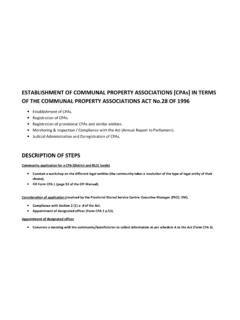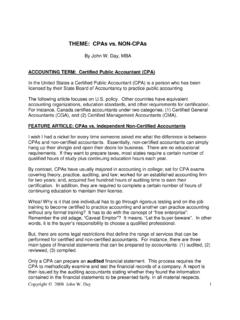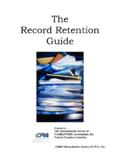Transcription of LIFO RESOURCE GUIDE FOR CPAS - LIFO-PRO, Inc.
1 LIFO RESOURCE GUIDE FOR CPAS Prepared by LIFO-PRO, INC. 920 S 107 AveOmaha, NE 68114 (402) OF CONTENTS Page LIFO Opportunities abound 1 Why LIFO methods are seldom optimized and computation errors are common 1 Who should use the LIFO method? 2 Common LIFO misconceptions 2 Opportunities for CPAs to improve their clients LIFO situation 3 Advantages of using the IPIC LIFO method 4 ABCs of quick LIFO analysis 5 How LIFO-PRO, Inc helps CPAs 5 LIFO success stories 6 APPENDIXES: LIFO analysis tools: PPI & CPI index histories & charts available on Web site PPI & CPI inflation histories & charts provided by LIFO-PRO Quick LIFO pro forma analysis template PPI categories maintenance Excel file databaseExample showing how the Double Extension method can produce unexpected results PPI categories template Table of Contents for GUIDE for Planning & Implementation for IPIC LIFO Method 1 LIFO Opportunities Abound Opportunities abound for CPAs to help their clients with their LIFO inventory needs.
2 CPAs responsibilities include financial reporting and tax compliance and optimization of accounting methods to provide maximum tax savings and efficient and error free computations. Many accountants view the LIFO inventory method as a nuisance rather than an opportunity. LIFO is viewed as a nuisance because making the LIFO computations correctly can be time consuming and prone to error. Most CPAs lack the experience to assure the optimization of methods, accuracy of calculations and efficiency of making LIFO calculations. Few CPAs, including Big 4 CPAs have enough clients using LIFO to develop expertise in this area. LIFO expertise is hard to achieve without on-the-job training because the IRS Regs. are written by tax lawyers and are difficult to understand and LIFO reference materials are generally poor. The only way to gain LIFO expertise is on-the-job training. Virtually all LIFO situations provide opportunities for CPAs to provide valuable service to their clients because: LIFO methods are seldom used and this presents opportunities for CPAs toincrease their clients tax savings and simplify their LIFO computational with IRS Regulations is seldom found yet full compliance is possiblewhen IRS Regulations are understood by CPAs and LIFO methods are are also many companies not on LIFO that should be.
3 Determining whether a company would benefit from using LIFO and implementing LIFO calculations can be simple if you know how to go about this. Why LIFO methods are seldom optimized and computation errors are common Although the new IPIC method LIFO Regulations issued in 2002 simplified LIFO computations for many taxpayers, the LIFO Regs. are not simpler to understand. This is because: 1) the number of new rules and calculation methods increased in the new Regs. and 2) the Regs. are written by Washington IRS Accounting Methods lawyers for whom plainspeaking seems to be a foreign from confusing IRS LIFO rules, one of the reasons LIFO errors are so common(we seldom review error free LIFO calculations) is that no one ever does enough LIFO calculations and IRS filings for enough different companies to develop expertise in this area sufficient to ensure full advantage is taken of the tax saving benefits of LIFO and to provide assurance that the calculations are correct. Even the "LIFO experts" at the large CPA firms are limited in hands-on experience because they concentrate mostly on accounting methods and compliance.
4 The handful of written LIFO reference sources provides little help because they are written by college professors or accountants with little practical LIFO experience. 2 Reasons LIFO may be more beneficial in 2004 than in the past IRS LIFO Regs. issued in 2002 increased from 80% to 100% the amount of PPIor CPI inflation taxpayers could new Regs. elimination of the stage of production margin change adjustmentrequirement substantially reduces the volatility of LIFO new Regs. provide for simpler calculations for most Proc. 2002-9 makes most LIFO method changes automatic approval rates have increased for many goods in 2004 Who should use the LIFO method company or expectations of future profitability inflation inventoriesCommon LIFO misconceptions benefits will be minimal for companies with fast inventory turnover-Inventory turnover rate is irrelevant; only the amount of FIFO inventory value andinflation impact the amount of LIFO reserve increases require increasing FIFO inventory balances-Unless FIFO values decrease significantly, the amount of inflation is a far more importantdeterminant of LIFO expense than FIFO values and significant LIFO reserveincreases are possible even with sizable FIFO inventory inflation rates will not produce significant LIFO benefits-Consistent positiveinflation can produce sizable LIFO benefits for companies with significantinventories.
5 Sizable LIFO benefits are also possible for companies with smallinventories for which there is consistently high and Tax LIFO methods need to be consistent-This was true until the late1970s but the IRS Regs. LIFO conformity rule was changed at that time to requireonly the conformity of the LIFO election scope(goods on LIFO). The permit different book and tax LIFO (Lower-of-Cost-or-Market) reserves provide as much or more benefitthan LIFO-If this seems to be true for a company, the reserving method would notlikely pass muster with the IRS. Even if a LCM reserve may exceed the first yearLIFO reserve, the LIFO reserve will grow with continued inflation regardless of FIFO value increases and this is not true of LCM reserves. LCM reserves must be takeninto income when LIFO is adopted as a Section 481a adjustment but this is spreadover 3 years. If the IPIC LIFO method is adopted, this provides taxpayers a safeharbor which prevents the IRS from challenging bad tax methods in pre-LIFO periods.
6 3 Opportunities for CPAs to improve clients LIFO situations 1. Companies not using LIFO that should be-There are many companies not on LIFO that should be because of lack of knowledge of expected tax savings and effort required to convert to LIFO. 2. Partial LIFO election where inflationary goods are excluded-LIFO should be used for all goods for which there is inflation. 3. Using LIFO for goods with consistent deflation-Partial LIFO terminations can solve this problem for some companies. 4. Using of the Double Extension rather than the Link-Chain method-The use of this method is rarely advisable and often produces LIFO inflation volatility and unexpected results. See example comparing Double Extension to Link-Chain method example. 5. Use of the Internal index rather than the IPIC method-The IPIC method is a better choice for almost all companies. See section describing the advantages of the IPIC method. 6. Use of the Unit LIFO instead of Dollar Value method-This only makes sense for companies that would have separate pools for each inventory item.
7 Otherwise, Unit LIFO can substantially decrease LIFO tax savings. 7. Too many LIFO pools are used-The fewer the pools the better to maximize tax savings and simplify the LIFO computations. 8. Using pre-2002 IRS Regs. LIFO methodology-This may not only be a compliance problem but could prevent maximum tax savings. 9. Using CPI indexes when PPI indexes produce higher inflation-This is an increasingly popular idea which has helped some retailers maximize their tax savings. 10. Using discontinued PPI index categories-The categories for which the Bureau of Labor Statistics compiles indexes change twice a year with 20% of the categories discontinued after December 2003, so the categories used must be reviewed annually. 11. IPIC pool index calculation errors-These errors are very common for companies who use more than a few PPI or CPI categories. Just obtaining these indexes can be an adventure. 12. LIFO layer erosion calculation errors-The longer a company is on LIFO, the more likely these errors will occur usually as a result of incorrect layer erosion computations.
8 13. Using an incomplete "layers remaining only" LIFO layer history format-Carryforward schedules that don t show the original FIFO balances, indexes and LIFO layer for years for which those layers have been subsequently eroded is a common problem. 14. Incorrect Sec. 263a costs capitalized-Proper integration of this computation with the LIFO layer history is required and the more years a company is on LIFO, the less likely errors are avoided. 4 Advantages of using the IPIC LIFO method 1. Higher inflation indexes possible-Many companies have found PPI or CPI inflation rates to be consistently higher than their internal index inflation. An example of this is large supermarket chains for whom the CPI v. internal index difference has consistently been almost 2% for the past 10 years. 2. Less volatility of LIFO inflation-Many companies find PPI or CPI inflation rates to be less volatile than internal indexes. Two reasons for this are:1) PPI and CPI indexes reflect price changes for the entire and not a single company and 2) internal indexes are more reflective of raw materials prices and PPI or CPI indexes are more reflective of intermediate or finished goods prices and raw material prices are more volatile.
9 3. Fewer pools possible The IPIC Regs. provide for establishment of pools by PPI or CPI Major Groups. Since this pooling method is optional and taxpayers can use other methods provided for in the Regs., taxpayer using the IPIC method are assured than the number of pools they use will be no greater than and may be less than alternative methods 4. Index calculation simpler than internal indexes-Use of a published index precludes the need to calculate an internal index unless companies switch for tax LIFO only. Internal index calculations are usually a major undertaking and can be avoided if companies switch for book LIFO also. The IPIC LIFO weighted average index calculations can also be complicated if done manually but this problem goes away with automated LIFO software. 5. Easy way to switch from Double Extension-The IRS has been reluctant to permit changes from this method to the Link-Chain method, especially for companies whose annual turnover of inventory items is not rapid. Taxpayers can make this change as an automatic approval change which does not require IRS consent when electing the Link-Chain method at the same time as a change to the IPIC method.
10 Use of the Double Extension method invariably produces more volatile LIFO indexes than Link-Chain indexes, so it is important for most taxpayers using the Double Extension method to switch to the Link-Chain method. 6. Cutoff method accounting change-Prior year restatement of inventory balances is not required. 7. IRS audit exposure reduced for past years Companies switching to the IPIC method are provided a Safe Harbor by the IRS with respect to methods used in years prior to the change. IRS audit exposure may be eliminated in these areas: Statistical sampling - Many companies use internal index sampling methods not acceptable to the IRS. For example, a company s sampling method may not give new items an equal chance for selection as the IRS requires. Pooling - Many companies use pooling methods not authorized by the IRS. Taxpayers may elect the optional IPIC pooling rules thereby establishing an acceptable pooling method. Other - Some manufacturers still use the components of cost method despite its prohibition by the IRS.








